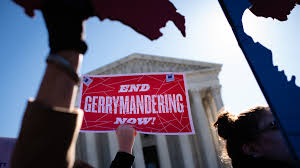
NDIANAPOLIS—Gerrymandering is the problem that prevents us from solving just about every other problem.
The fact that we have set up a system of electing to the legislative branch unreasoning and unrelenting partisans who feel accountable only to people who think exactly the way they do warps every part of government. It paralyzes what should be our system of resolving differences and turns even trivial matters into high-stakes, winner-take-all-loser-be-crushed conflicts.
Gerrymandering—the practice of drawing maps for legislative districts to give one party or another a disproportionate edge—adds immeasurably to the strife in our divided country and state.
Gerrymandering has been around from the earliest days of the republic. It draws its name from Elbridge Gerry.
Gerry was briefly vice president under President James Madison. He also signed the Declaration of Independence. He was one of only three delegates to the Constitutional Convention who refused to sign that august document until it included a bill of rights, a defect he helped remedy as a member of the first Congress.
All that worthy service to the fledgling nation, though, has been overshadowed by Gerry’s more dubious contribution to history. While he was governor of Massachusetts, he oversaw a redistricting effort that resulted in a map that included a Senate district that a cartoonist caricatured as resembling a salamander and called a “Gerry-mander.”
The name, simplified to gerrymander, took up permanent residence in the nation’s vocabulary.
So, sadly, did the practice.
Through the decades, both Democrats and Republicans have resorted to gerrymandering. The desires of politicians to gain or hold onto power through any means, just or unjust, are nothing new.
What is new, as Janet Williams and Bill Theobald of The Indiana Citizen demonstrate in a deeply reported story on Indiana’s 2011 redistricting efforts, is how technological advances have enhanced gerrymandering.
(Disclosures: Janet is a former executive editor of TheStatehouseFile.com. She, Bill and Indiana Citizen editor Kevin Morgan all are old friends and former colleagues of mine from our newspaper days. And The Indiana Citizen and TheStatehouseFile.com are partners.)
What the two reporters demonstrate in dispassionate but chilling detail is that what once was a dark and imprecise art practiced with paper maps and magic markers now is a precise science applied with surgical, laser-like accuracy. Politicians now can pick the voters they want with ease, almost as if they were ordering items off a fast-food menu.
I could summarize the reporting Janet and Bill did, but you really should read it for yourself: The room where it happened: A decade after Indiana’s 2011 redistricting, those on the inside still aren’t talking – TheStatehouseFile.com | TheStatehouseFile.com.
This matters for at least three important reasons.
The first is that the Indiana General Assembly’s preoccupation with minor and often divisive matters—permitless gun bills, measures to regulate usage of public restrooms—is a product of a process that rewards extremists who seek election to the legislative branch and punishes more reasonable, rational candidates. The folks that gerrymandering pushes into the legislature want fights, not solutions.
The second is that gerrymandering exacerbates the natural—and somewhat healthy—tension between the legislative and executive branches. One reason Indiana Gov. Eric Holcomb and the General Assembly have gone to court to resolve a constitutional crisis involves redistricting. Governors and other officials who run statewide must balance the interests of all Hoosiers to be elected and fulfill their duties of office. Lawmakers from gerrymandered districts only have to consult the face in the mirror.
But the last reason is the most significant.
Indiana, like other states, now is engaged in the redistricting process required after every census. This is the moment for Hoosiers to make their voices heard about the kind of government they want—about whether they want a system in which citizens choose their leaders or whether we will continue to allow politicians to pick their voters.
It is our chance to say that we want a government that helps us resolve our differences, aids us in meeting the challenges before us, rather than making problems worse and driving us further apart.
Make no mistake about it.
Indiana, like every other place on earth, does face difficult problems, but none are so immense that we cannot solve them if we summon the will and the good sense to work together.
That is why gerrymandering is the problem we must solve before we can solve every other problem.
John Krull is director of Franklin College’s Pulliam School of Journalism and publisher of TheStatehouseFile.com, a news website powered by Franklin College journalism students.


